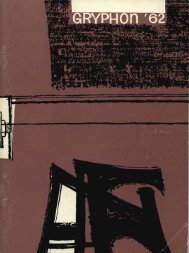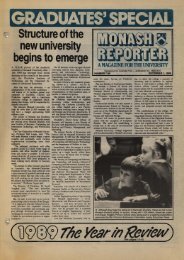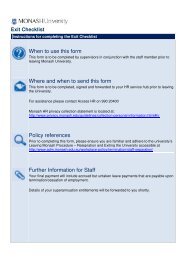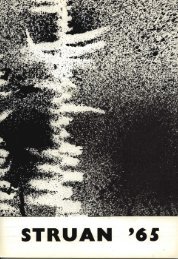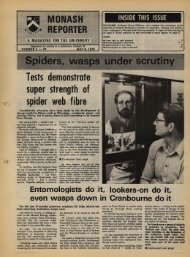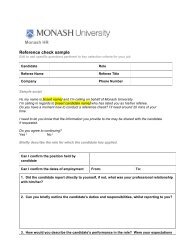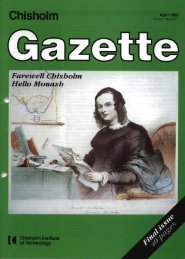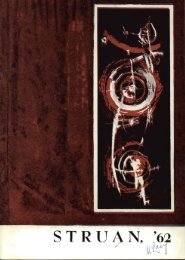GAZETTE - Adm.monash.edu.au - Monash University
GAZETTE - Adm.monash.edu.au - Monash University
GAZETTE - Adm.monash.edu.au - Monash University
- No tags were found...
Create successful ePaper yourself
Turn your PDF publications into a flip-book with our unique Google optimized e-Paper software.
in a similar market situation to his own. These conditionsare most likely to be formed in small towns andrural areas, but also, of course, anywhere where therelationship between employer and worker is personaland particular.3. The "privatised" worker, His model of society ispecuniary. Class divisions are seen mainly in differencesin income and material possessions. He is likely to workin a large factory. His involvement in his job and hisattachment to the enterprise and to his fellow workersare slight. He does not form cohesive groups with otherworkers either inside or outside the factory. Work is anecessary evil. His work situation (relative to the othertwo types) is socially isolating and socially meaningless.His community life is centred in the low-cost housingestates whose population has two things in common,residential mobility and a livelihood involving manuallabour. His status order is based on conspicuousconsumption.Lockwood intended these types to apply to manualworkers, but the variables involved seem sufficiently generalin society to make it interesting to test them againstthe white-collar and middle-class strata as well.The only part of this study that has been carried outso far is the postal survey of three of the south-easternsuburbs, and the analysis of the results of this has hardlystarted, so the rest of this note must be confined to adescription of how this survey was carried out.The three districts were selected according to thelikelihood of each yielding a stratified random sample ofalmost 300 people from the electoral rolls who wouldbelong to either the blue-collar group, the white-collargroup or the middle-class group. There was nothingspecial about this approximate figure of 300 except thatit was thought to be financially possible to send outabout 900 or 1,000 questionnaires but not many more.The lists used for sampling were the latest electoralrolls obtainable and the Sands and McDougall Directoryof Victoria 1967.Postal surveys are not usual where personal interviewingis possible since the response rates tend to be low anda thirty to forty per cent return would not be consideredbad. There seemed to be four main factors which suggestedthat the response rate for our questionnaire couldbe very low. First was the length of the questionnaire;there were fifty questions, some short and easy toanswer, and others more complex and rather long.Secondly, the sample was not any special part of thepopulation (e.g., members of an association) but was,apart from the occupational groupings, entirely unselected- in fact the kind of sample which most studiessuggested would yield a response rate so low as to beuselcss.t Thirdly, this survey could in no sense be calledan "official" one, that is, it could obviously not relyon the sense of duty, compliance and self-interest whichassist the response rates in, for example, a survey carriedout by a government department. Fourthly, a third ofour sample was from the blue-collar stratum and previousstudies suggested that the lower the <strong>edu</strong>cationallevel, the lower the response rate.W. G. Goode and P. K. Ratte-Methods in SocialResearch, McGraw-Hill, New York, 174, 1952.Stanley S. Robin - A proc<strong>edu</strong>re for securing returnsto mail questionnaires. Sociology and Social Research,L, No. J, October 1965.A careful search of the available literature on postalsurveys was made and, of all the writers on this topic,only one seemed to have at least a partial answer to thedifficulties.v None of the methods advocated was newbut Robin's technique involved a careful blend ofmethods already tried separately in the past. The essenceof this method was to present an interestingquestionnaire after an introductory Jetter and to followup with several carefully-phrased reminder letters. Inevery case the letters were made to look as "personal"as possible.Om introductory leiter was sent out to 900 heads ofhouseholds on 29 November last year. The letter explainedthe purpose of the research and that the individualwas requested to help by filling in a questionnairewhich was to follow. It was emphasized that the individual'sidentity would remain confidential and that he wasselected from a random sample. The respondent wasthanked for his assumed co-operation.Six days later the questionnaire and covering letter,together with a stamped, addressed envelope for the returnof the questionnaire, were posted. The coveringletter again emphasized the confidential aspect and repeatedseveral more of the points from the introductoryletter. On 12 December, if the individual had notalready replied, the first reminder letter was posted.This reminded the individual of the importance of hiscontribution to the research and again thanked him inadvance for his co-operation.Three days later, if no reply had been received, asecond reminder was sent together with a second questionnaireand another stamped, addressed envelope forthe return of the questionnaire. This letter suggestedthat as we had not heard from the individual he mighthave mislaid the questionnaire and, in case he had, wewere enclosing a second with another stamped, addressedenvelope.Six days after this a third reminder letter was sentif there was still no response. This time the individualwas invited to get in touch with the department byphone or letter if he had lost both previous questionnairesand another would be sent. No intimation wasgiven that this would, in fact, be the last reminder letter.The actual final response achieved by using this kindof approach was as follows.This represented a total response rate of sixty-nine percent, which is amongst the best recorded for this kindof survey.Questionnairescompleted andreturnedNot heard fromat allMoved fromaddressDeceasedOther nonresponsesforvarious reasonsBluecollarWhitecollarMiddleclassTotal203 202 217 62250 50 42 14213 19 11 433 2 4 931 27 26 84300 300 300 90031




